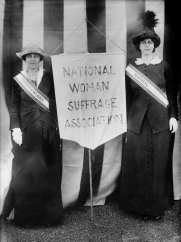A woman’s act onstage and off
During the mid 19th and early 20th century, the women’s suffrage movement was paralleled by the struggle for equal opportunity in vaudeville by women. Women were struggling for the right to vote and the equality of women in society as they began to emerge from the domestic sphere.Many suffragettes were arrested and sent to jail for their protests. There were strict public and social standards for the behaviors that were acceptable for women. Suffragettes consistently challenged the status quo of society, just as female vaudevillians often challenged the status quo within the world of vaudeville.Onstage there was a similar struggle for equal opportunities for women. Alison

[3]
Sex and Femininity
A sub-type of vaudeville was the burlesque show. The focus of the burlesque show was to focus on a “…woman’s body and featured scantily-clad women, often in the act of undressing.” [4] However, vaudeville was more than just women getting undressed.
It was, and is, a blend of musical numbers, dancing, comedy, and satire. Burlesque featured a sexuality not permissible in everyday society.Robert C. Allen in his book Horrible Prettiness noted that Burlesque was “the most thoroughly feminized form of theatrical entertainment in the history of the American stage to that time.” [5]
Burlesque, needless to say, went against the ‘clean family variety acts’ espoused by Keith and Albee, who controlled one of the most dominant vaudeville circuts in the United States. However that is not to say that Keith and Albee did not inadvertently demonstrate sexuality.In Blue Vaudeville, Andrew L. Erdman noted that there was a need
to get mothers and daughters into the vaudeville shows. There were also strict rules of conduct for both audience and performer. “It was safe, not rough; trustworthy and purified, rather than suggestive of society’s dark underside it’s connections with working-class culture and with work-class sexuality severed. Thus it paved a way for what might be seen as a middle-class sexuality, a tolerable is not openly advisable, way to get the titillating goods from the burlesque hall and the variety theater onto the refined, stamped-safe-for-the-middle-class vaudeville stage.” 6 Many women vaudevillians made the transitions from the stage to the silver screen. Both ranges of the female stock acts (burlesque, darling, athletic etc.) Mae West is one of the many examples of women who transitioned from burlesque to the movies.Works Cited
1. Suffragists Mrs.Stanley McCormick and Mrs. Charles Parker, April 22, 1913. 1913. Photograph. Wikipedia.
2. Kibler, M. Alison. Rank Ladies: Gender and Cultural Hierarchy in American Vaudeville. Chapel Hill: U of North Carolina, 1999. Print.
3. Tiger Bride. 1930. Photograph.Flikr. https://www.flickr.com/photos/sanspareille/276438377/
4 .American Variety Stage – About These Motion Pictures.” American Variety Stage – About These Motion Pictures. Web. 15 Apr. 2015. <http://memory.loc.gov/ammem/vshtml/vsflme.html>.
5. Allen, Robert Clyde. Horrible Prettiness Burlesque and American Culture. Chapel Hill: U of North Carolina, 1991. 137. Print.
6.Erdman, Andrew L. Blue Vaudeville: Sex, Morals and the Mass Marketing of Amusement, 1895-1915. Jefferson, N.C.: McFarland, 2004. 12. Print.
7. Ziegfeld Follies Publicity. Fanny Brice, Ziegfeld Follies photo, 1910s or start of 1920s. n.d. Photograph. Wikipedia. Bradford, Harlan. Comedian- Brice, Fanny. Harlan Bradford Collection. Cleveland Colby Colgate Archives, New London NH. 2015


